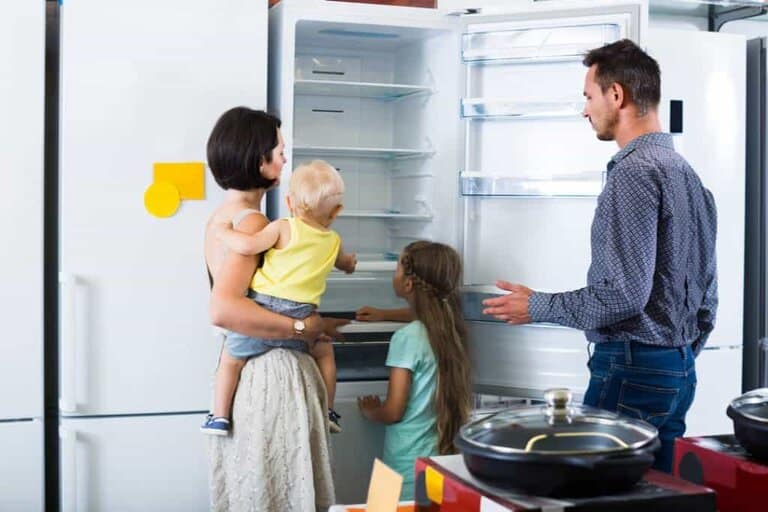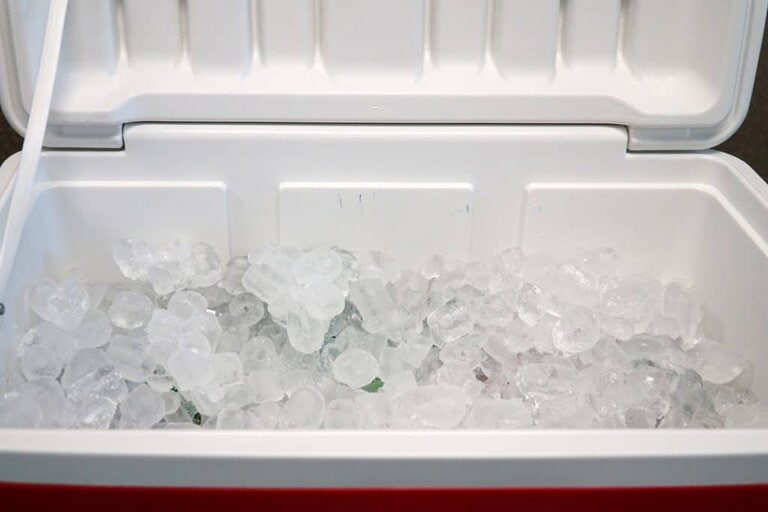To keep your food safe while waiting for your new generator, separate your food items and place those that can withstand room temperatures on the shelves. Grab a cooler, fill it with ice, and put your remaining food items in them. Close the cooler tightly until you are ready to transfer your food items to your new fridge
You’ve gone through various appliance catalogs, considered the best configuration suitable for your needs, secured the delivery date with the installers, and created a space for your new fridge in your home.
You’ve ticked all the boxes and are all set for your new appliance until you realize you missed an important step in your quest to switch to a more efficient refrigerator. What do you do with the frozen foods in your old refrigerator?
Most refrigerators take 2 to 24 hours to cool and reach the FDA food-safe temperature of 40°F. So you need to figure out other ways to keep your food safe during that period.
Below are a few tips to avoid food wastage and have a smooth transition to your new refrigerator.

How Do I Keep My Food When Getting A New Refrigerator?
Here are two simple yet effective steps to keep food fresh until your new refrigerator is safe enough for your foodstuffs.
Step 1: Separate Your Food Items With High Shelf Life
Not every food item in your refrigerator is going to go rancid without cold temperatures, So you should be able to store some on the counter or shelf while the new refrigerator gets ready for use,
So what Food items do not go bad quickly and can sustain the waiting period?
- Leafy greens would stay healthy with just a little bit of water.
- Canned foods and drinks would do just well on your shelves.
- Potatoes and herbs can stay on your counter for a few days without worrying.
- Fruits usually have a shelf span of about two days.
After deciding what food item can stay on the counter shelves, you can go ahead to preserve your frozen food that is prone to easy spoilage by using a cooler.
Step 2: Grab a Cooler
This part requires very few things and can be a lifesaver until you get your new refrigerator running.
To get started:
- Grab a cooler at home and some ice. You can easily get ice by walking down to a nearby store.
- After getting your ice, pour some at the bottom of your cooler. (Try not to fill beyond halfway)
- Then put your food items gently in the cooler.
- Now, Pour some more ice into the cooler and fill to the brim.
- Finally, close your cooler and make sure not to open it until you are ready to transfer your food to the new refrigerator.
These steps should be all you need to keep your food at food-safe temperatures until your new refrigerator is good to go. However, below are a few alternatives you may want to consider if you find them convenient.

Use The Garage
If you don’t intend to use your old refrigerator anymore, this is an ideal alternative.
Start by:
- Creating a space for your old refrigerator in the garage
- After moving the old refrigerator to the garage, pour some ice inside if it is unplugged.
- Then, transfer all food items, and wait till your new refrigerator is done cooling.
The Family and Friends Option
Family and friends are one place we all get most of the support we need in life. And an emergency food storage situation is not so different.
- If you stay around your family and friends, you can always ask them if they have extra space for you to keep a couple of food items for a while.
So When Can You Put Food In Your New Refrigerator?
Ideally, this should be after 24 hours. However, this depends on factors like the size of your new refrigerator.
Putting your food too early would only cause your compressor to overwork as it would be cooling both the cooling lines and your food. So this is not a great way to start.
Here is the waiting time for each refrigerator type.
- Standard refrigerators: 3-24 hours.
- Mini refrigerators: 4 hours.
- Freezers: 12 – 24 hours
I can not wait up to 24 hours for the new refrigerator to cool; what can I do?
Tips To Make Your Refrigerator Cool Faster
- Keep your refrigerator away from the wall to ensure it dispels heat quickly.
- Pour some ice into your new refrigerator to support its cooling process.
- Resist the urge to open your fridge. The longer it stays shut, the faster it cools.
Pro-tip.
You can set the temperature of your refrigerator to its max before you begin usage, then later adjust it back to 40° F, the FDA-recommended food-safe temperature for refrigerators.
How To Transfer Your Food Into Your New Refrigerator When It’s Cool Enough
- Once your refrigerator is done cooling, get your food cooler.
- Arrange your food properly in the suitable refrigerator compartments (Read on to find out the best practices)
- Close Your Refrigerator and allow your food cool
The Best Way To Arrange Your Food In Your New Refrigerator

A refrigerator has compartments that are best suited for various food items. Here Is a list of each compartment and what they are best suited for.
Upper shelves: They have the most consistent temperature and are most suitable for foods that do not need cooking.
Lower shelves: This is usually the coldest, and it’s perfect for your dairy products, beef, and chicken. It also ensures that water from these, especially meat, does not go into your other food items.
Crispy Drawers: These are for fruits and vegetables, it serves to maintain the moist conditions your fruits and veggies need.
Refrigerator Door: Items like your drinks and fruit juices can find a home in this section of your refrigerator.
FAQS On What To Do With Food When Getting A New Refrigerator
Do I have to Wait Before Plugging in The New Refrigerator?
Unless a refrigerator is transported in an upright position, it is vital to allow it to stand upright for at least four hours before plugging it into electricity. This enables the compressor oil to flow back to the compressor so it won’t cause any damage later.
How Long Can Perishable Food Items Stay At Room Temperature?
Perishable food items at room temperature are prone to bacteria contamination after about two hours. So the FDA recommends discarding them at this point.